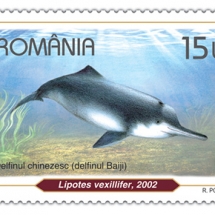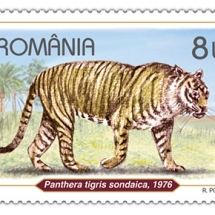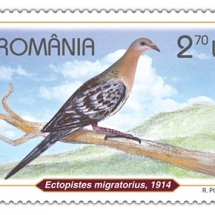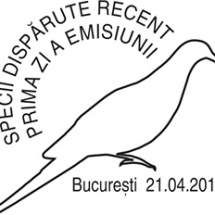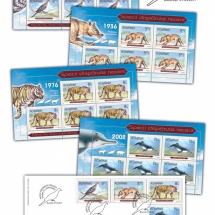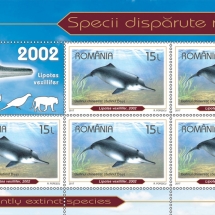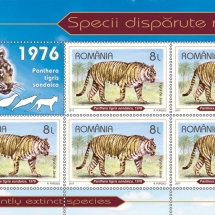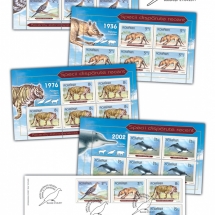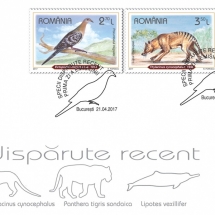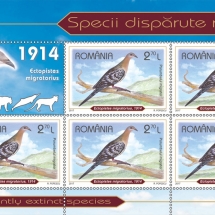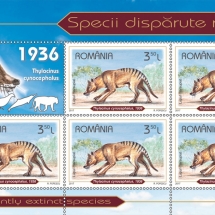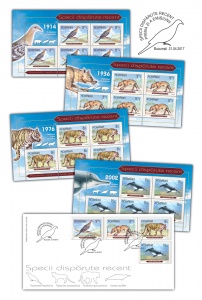 Over the geological ages, climate change or intense volcanic activity resulted in the complete disappearance of part of the flora and fauna on Earth. The list of factors that negatively influenced the plants and animals of the planet also includes the human being. Thus, by excessive hunting, habitat destruction, commercial exploitation or pollution the list of species classified as endangered or near extinction is enlarged every year.
Over the geological ages, climate change or intense volcanic activity resulted in the complete disappearance of part of the flora and fauna on Earth. The list of factors that negatively influenced the plants and animals of the planet also includes the human being. Thus, by excessive hunting, habitat destruction, commercial exploitation or pollution the list of species classified as endangered or near extinction is enlarged every year.
Romfilatelia, through the postage stamp issue Recently Extinct Species wants to raise the awareness on the role that all humanity has, responsible for the protection of the planet.
This issue, comprising of four face values is available starting on Friday, April 21st, 2017 in Romfilatelia shops in Bucharest, Bacau, Brasov, Cluj-Napoca, Iasi and Timisoara.
The passenger pigeon or wild pigeon (Ectopistes migratorius), illustrated on the stamp with the face value of Lei 2.70, is an extinct species of pigeon that was endemic to North America, where in the past it was very widespread.
Passenger pigeons were hunted by Native Americans, but hunting intensified after the arrival of Europeans. Pigeon meat was commercialized as cheap food, resulting in hunting on a massive scale for many decades. At the end of the 19th century their numbers dropped significantly, the main reasons for the extinction of this species being the massive scale of hunting, the fact that a pair would produce a single egg as well as the rapid loss of habitat.
The last recorded nest and egg in the wild were collected in 1895 near Minneapolis. Martha, the last of her kind in captivity, died of old age on September 1, 1914, in the Cincinnati Zoo.
Thylacinus cynocephalus, Greek for “dog-headed pouched one”, was the largest known carnivorous marsupial of modern times and is illustrated on the stamp with the face value of Lei 3.50. It is commonly known as the Tasmanian tiger or the Tasmanian wolf. Native to continental Australia, Tasmania and New Guinea, it is believed to have become extinct in the 20th century.
Intensive hunting, encouraged by bounties, was named as the main cause of its disappearance, although other factors are to be considered as well, such as diseases and human trespass on its territory.
The last captive thylacine, later referred to as Benjamin, was trapped in 1933, and sent to the Hobart Zoo where it lived for three years. This last thylacine died on September 7th 1936.
The Javan tiger (Panthera tigris sondaica), illustrated on the stamp with the face value of Lei 8, is an extinct tiger subspecies that inhabited the Indonesian island of Java until the mid-1970s.
The Javan tiger was a small size subspecies, compared to other subspecies to the Asian continent. Among the possible causes of their extinction are the human activities and reduction of their habitat.
The last tiger was sighted in the Meru Betiri National Park, in 1976. Since then, not a single cub has been recorded.
The Baiji (Lipotes vexillifer), illustrated on the stamp with the face value of Lei 15, is the only representative of the Lipotidae family, being a functionally extinct species of freshwater dolphin, formerly found only in the Yangtze River in the People’s Republic of China.
The Baiji population declined drastically as the People’s Republic of China industrialized and made heavy use of the river for fishing, transportation, and hydroelectricity.
It has been claimed, after surveys in the Yangtze River during the 1980s, that the Baiji is the first dolphin species in history that humans have driven to extinction. Efforts were made to conserve the species, but a late 2006 expedition failed to find any Baiji in the river.
These are only a few examples to remind us that we have a duty to learn from our past mistakes and to preserve the species that are now in danger of extinction, because a few decades are enough to eradicate species that have evolved in balance with our planet for millennia.
The issue is completed by a first day cover and, as a page composition, were used the sheet of 32 stamps and minisheet of 5 stamps + 1 label.
Romfilatelia thanks the “Grigore Antipa” National Museum of Natural History for the documentary support granted in the creation of this postage stamp issue.
For further information, please contact the Public Relation Office:
Tel: 021 / 337 24 42
anamaria.anton@romfilatelia.ro



